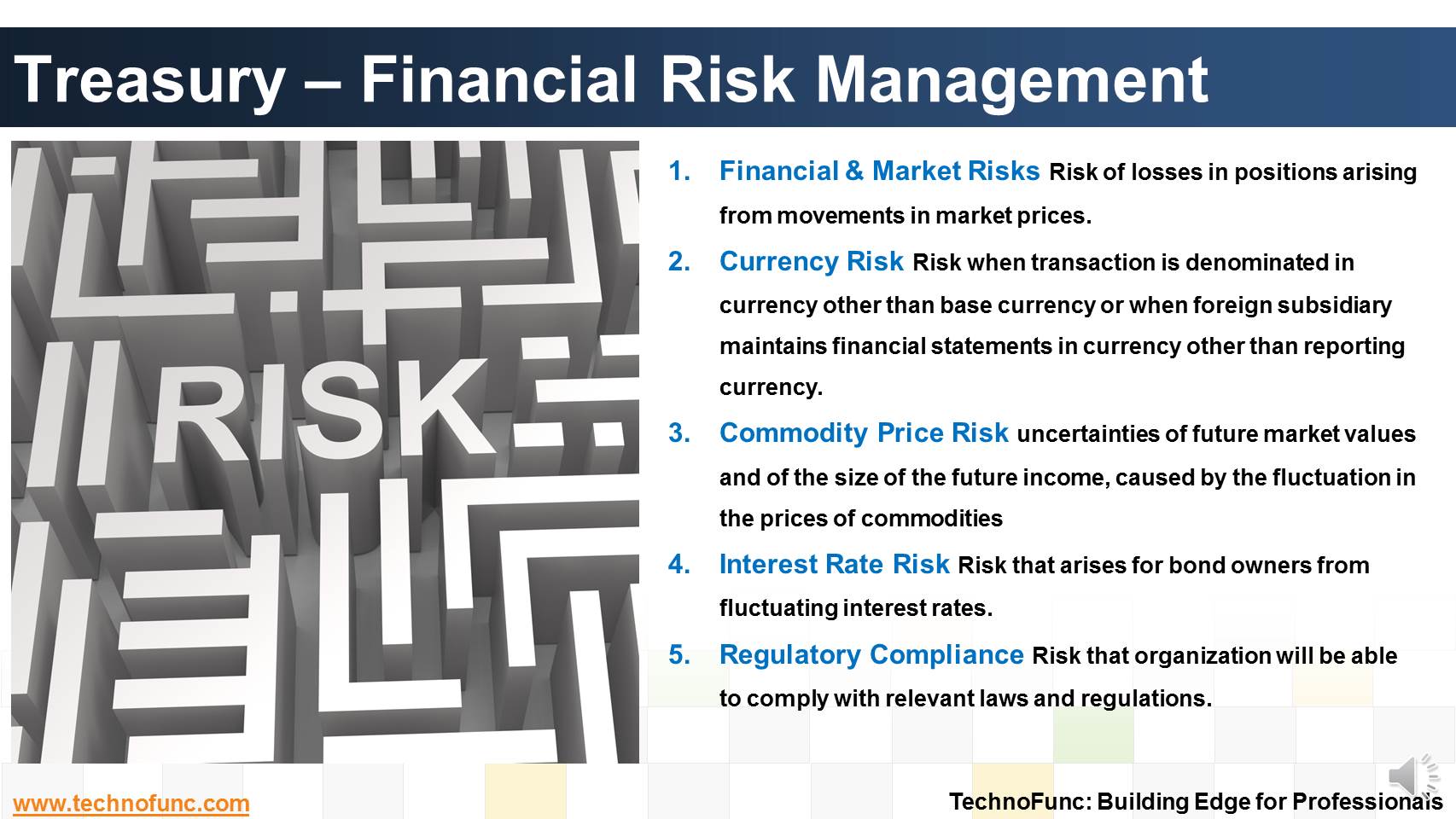- Home
- Business Processes
- Industry Knowledge
- Aerospace Industry
- Automotive Industry
- Banking Domain
- BFSI Industry
- Consumer/ FMCG Industry
- Chemicals Industry
- Engineering & Construction
- Energy Industry
- Education Domain
- Finance Domain
- Hospitality Domain
- Healthcare Industry
- Insurance Domain
- Retail Industry
- Travel and Tourism Domain
- Telecom Industry
- Leadership Skills
- eLearning
- Home
- Business Processes
- Treasury Management
- Financial Risk Management
Financial Risk Management
The objective of Financial risk management is to protect assets and cash flows from any risk. Treasury function works to accurately assess financial risks by identifying financial exposures including foreign exchange, interest rate, credit, commodity and other enterprise risks. Learn about the various risks that are managed by treasury.
The objective of Financial risk management is to protect assets and cash flows from any risk.
Treasury function works to accurately assess financial risks by identifying financial exposures including foreign exchange, interest rate, credit, commodity and other enterprise risks.
And then try to manage the market based on those risks. It must develop effective hedge strategies after gaining real-time insight into a variety of risk positions that translates into less exposure.
You can differentiate between risks from changes to stock prices, interest rates and exchange rates.
Financial & Market Risks
Here the objective is to control and monitor the financial and market risks a company is exposed to. Treasury should identify explicit and implied financial risks, credit risks and operational exposures and modal risk mitigation strategies.
Market risks result from the danger of negative market developments (changes to parameters on the money and capital markets), which in turn affect the financial assets of a company.
Treasury system creates and maintain all the market data required to value financial instruments -both real data and fictitious data to run scenarios.
Some instruments that are exposed to market risks are; Bonds, Loans, Money market transactions, Forward rate agreements; Swaptions; Futures; Bond options; Options on futures
Currency Risks
Currency Risk and foreign exchange risk arises when transaction is denominated in currency other than base currency or when foreign subsidiary maintains financial statements in currency other than reporting currency.
Some instruments that are exposed to currency risks are Forward exchange outstanding transactions and Currency options.
Commodity Price Risk
Commodity Price Risk refers to uncertainties of future market values and of the size of the future income, caused by the fluctuation in the prices of commodities.
Commodity risk management is to identify, quantify, and mitigate exposure to commodity price and foreign-exchange risk.
Robust analytics is used to understand risk positions in real time, that reduces price risks resulting from core business operations with appropriate hedging.
Interest Rate Risk
Risk that arises for bond owners from fluctuating interest rates.
It impacts bonds, Interest rate guarantees, Interest rate swaps and cross-currency interest rate swaps.
Regulatory Compliance
There is always an inherent risk that organization will not be able to comply with all relevant laws and regulations that may result in fines and penalties.

<p><a href="https://technofunc.org/index.php/business_courses/programs/4-business_courses/15-treasury-management-overview"><img src="/~technofu/images/Frontpage/Functional/Ad_Horizontal/Treasury.jpg" alt="Treasury" width="2000" height="600" style="margin: 10px; float: left;" title="_TechnoFunc" /></a></p>
Related Links
You May Also Like
-
Treasury Management - Functions
Treasury management has become an specialized function. Treasury function helps in managing the Risk-return profile as well as the tax-efficiency of investment instruments. In larger firms, it may also include trading in bonds, currencies and financial derivatives. Learn about the various tasks, activities and imperatives, undertaken by treasuries in in today's context.
-
Treasury has increasingly become a strategic business partner across all areas of the business, adding value to the operating divisions of the company. Managing activities that were traditionally carried out within the general finance function. Learn about the drivers for this change.
-
The objective of funding Management is to implement strategies that lead to the best borrowing rates and lower investment costs. Learn how treasury aids in loans and investment management functions.
-
The objective of Financial risk management is to protect assets and cash flows from any risk. Treasury function works to accurately assess financial risks by identifying financial exposures including foreign exchange, interest rate, credit, commodity and other enterprise risks. Learn about the various risks that are managed by treasury.
-
Although there is no straight forward answer to the question, how to best organize a treasury function, this article provides an generic view of the way large MNCs creates departments or sub-functions within the treasury function.
-
Treasury Management - Benefits
Effectively using treasury management with cash management and trade finance products brings tangible benefits to both corporates and financial institutions. Let us discuss some tangible benefits of treasury function.
-
Technology has enabled the treasury function by providing various solutions to manage it's complicated tasks. This article explains various types of treasury management systems available in the market.
-
The terms Treasury Management and Cash Management are sometimes used interchangeably, while, in fact, the scope of treasury management is larger and includes funding and investment activities as well. Learn all about Treasury Management here!
-
The Cash Management component ensures that the enterprise has sufficient liquidity for payments that are due and to monitor payment flows. Learn how treasury plays an important role in cash management for the enterprise.
Explore Our Free Training Articles or
Sign Up to Start With Our eLearning Courses

About Us
Learning
© 2023 TechnoFunc, All Rights Reserved









